Managing Disks
Partition and Volume Management
Creating Partitions and Volumes
- You can create partitions and volumes using either the Disk Management snap-in or the DiskPart command-line utility. This task requires Administrator privileges.
- Basic disks follow simple partition rules. Only primary,
extended, and logical partition types can exist on a basic disk. The rules for creating basic disk partitions are sumamrized in Table 4-2.

- Dynamic disk technology supports five types of vol-
umes, some of which can use multiple disks and provide fault tolerance. Windows 7 versions
that support dynamic disks fully support simple, spanned, mirrored and striped volumes. Fault
tolerant RAID 5 volumes are supported only in server-class operating systems.
The number of dynamic volumes supported on a disk is limited by the space in the database
used to track dynamic volumes. A copy of the database is kept on each dynamic disk on the
computer and takes up 1 MB of disk space on each disk. The database has enough room to store
details about several thousand individual volumes. The rules for the existence and creation of
dynamic volume types are summarized in Table 4-3.

Activity 4-6

